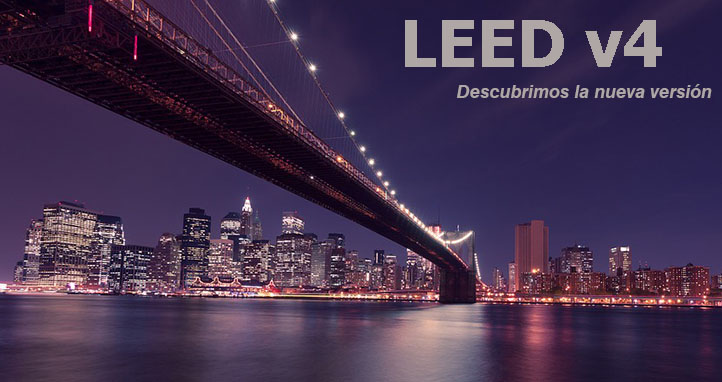The new version of LEED, exclusively valid since November 2016, thoroughly reviews many credits, giving greater importance to measures that incorporate sustainability from the beginning of the project. Leave as the most difficult measures to achieve, those that can be incorporated as additions in the final stages of construction.
Origin of the tool and end of the 2009 version
The LEED sustainability certification is a tool that was developed by the USGBC in 1998 to objectively assess the sustainability of buildings. It is a constantly evolving tool. Since its launch, it has been continuously reviewed to ensure its rigour and adaptation to changes in the building industry, becoming increasingly holistic, in line with the most demanding climate change mitigation objectives. The new version 4 replaces the previous one called 2009, and since last November, buildings can no longer be registered with the old version.
Since last November, projects can no longer be registered with the 2009 version (LEED Certification Deadlines), giving way exclusively to the new version 4.
Main Innovations LEED V4
Achieving a sustainable building without incurring substantial cost increases means applying sustainable design and construction strategies as part of the process, not as an add-on at the end of the project. If we do not apply this new way of working in our projects, we may find that obtaining high ratings with LEED V4 is much more costly than with the previous version.
LEED v4 places great importance on the integrated design process and site analysis, and incorporates new options for credit compliance such as the building life cycle analysis in the materials and resources category, with which up to 6 points can be obtained and even an extra point for exemplary performance. There is also a new category, location and transport, and new requirements such as continuous monitoring of air quality.
.png?width=1608&height=755&name=Compartiva%20LEED%20V4%20(2).png)
Comparison of scores by category between LEED 2009 and v4
Integrated design process and team
The new version of LEED proposes an integrated design process that consists of three fundamental phases. The first one is the Discovery phase, which consists of a preliminary analysis of the site conditions, the findings of which will affect the design and operation of the building: topography, hydrology, climate, vegetation, soil, human use and effects on human health. This phase concerns the new credit Site assessment, and all the information obtained is compiled in the Site assessment worksheet for the justification of the credit.
The next phase is the conceptual design which begins with the development of the schematic design. In this phase, the new credit Integrative Process appears, which identifies the most suitable design strategies to optimize energy and water consumption. For this, a basic energy modelling of the building is carried out, which analyses different parameters such as the most suitable orientation or the composition of the envelope; while for water use, a demand calculation (interior and exterior) is performed and different possibilities to reduce it are analysed, such as the reuse of rainwater or greywater.
An efficient design in these initial phases allows achieving sustainability goals without increasing construction costs (short term) but also reducing resource consumption costs throughout the building's useful life (long term). The development of the building design continues to take these demand reduction strategies into account until the final design is obtained, and ends with the development of the executive project, bidding, and construction.
Finally, in the occupant phase of the building, the operation of the building is continuously analysed by means of a monitoring plan, the correct operation of the systems is verified and any anomalies detected are corrected in a process of continuous improvement.
.jpg?width=1096&height=539&name=Integrative-Process%20(1).jpg)
Integrated design process in three phases: research, design and construction, and building occupancy
New category "Localization and transport"
Building on the "Sustainable Plots" category of the 2009 version, this new category has been created which includes different aspects to be considered in the selection of a sustainable site.
The following aspects are: promoting the execution of projects in previously developed areas, choosing areas with ample availability of public transportation, enhancing socially and economically vulnerable areas, avoiding environmentally sensitive zones, facilitating connectivity with basic services, limiting parking, encouraging the use of bicycles and the use of alternative means of transportation (electric vehicles, car sharing, etc.).
Two of the main new features compared to the previous version are:
- The new requirement for compliance of the credit: Bicycle facilities, which requires a bike lane network located less than 180 m from the site.
- A greater requirement to obtain points in the public transport criterion, requiring a series of minimum public transport services per day.
For the rest of the requirements that already come from other credits, the level of demand has also been increased. For example, the distance to the destinations measured through safe infrastructures will not exceed 4.8 km from the project area. Additionally, a minimum capacity for short-term and long-term parking is required, as well as locker rooms with showers for cyclists.
Credits for the improvement of the sustainability of the Plots: "Sustainable Plots"
The credits that remain in this category are related to rainwater management, the reduction of the heat island effect and light pollution, habitat protection, and the regeneration of degraded spaces. It includes a new credit, Site assessment, already mentioned at the beginning.
The credits related to runoff management in the 2009 version are merged into a single credit with three different options, depending on the amount of rainwater to be managed (percentile) or if it is a high density urban area. Rainwater management proposals should replicate the natural hydrological process through low impact infrastructure (LID) and green infrastructure (Green Infrastructure).
Finally, the Light Pollution Reduction credit removes the indoor lighting requirements of the 2009 version and includes the BUG Rating (Backlight-Uplight-Glare) method for credit justification as one of two possible options.
Efficiency in water use, indoor and outdoor
The water efficiency category incorporates two new pre-requisites. The first is to ensure a reduction in outdoor water use, either by justifying a minimum saving of 30% compared to the baseline calculation through the appropriate selection of plant species and efficient irrigation systems, or by proposing a landscaping solution that does not require permanent irrigation. The second new pre-requisite is to ensure the metering of the total indoor and outdoor drinking water consumption by installing permanent water meters. In this prerequisite, measurements must be shared with the USGBC for 5 years.
It also includes two new credits: Cooling tower water use and Water metering. In addition, up to 6 points (previously 4) can be earned for the Indoor water use reduction credit.
Environmental product declarations and life cycle analysis for the category "Materials and Resources"
The main novelty affects the credits related to the selection of construction materials and the life cycle analysis. Aiming to reduce the impacts associated with the extraction, transformation, transport and generation of waste associated with the construction of buildings. In all credits in this category, points can be earned for exemplary behaviour.
On the one hand, the Building life-cycle impact reduction credit proposes different options: reuse of historic, abandoned or derelict buildings, recovery of construction materials (on-site or off-site) for reuse, and life cycle analysis (Cradle to Grave) demonstrating impact reduction in at least 3 categories, including global warming potential.
Credits related to the material selection of the 2009 version disappear and are incorporated into the new credits. The availability of rigorous information on the life cycle and associated impacts through environmental product declarations is rewarded, as well as on the content of chemical ingredients in materials or ingredients that can generate harmful substances.
Responsible management by manufacturers, extended producer responsibility, selection of regional materials, reuse, and the use of materials with recycled content are rewarded.
Monitoring and higher level of requirements in the "Energy and Atmosphere" category
In this category, a new pre-requisite is added to the three pre-requisites of the 2009 version. It is called building-level energy metering, similar to the pre-requisite of measuring total water use in the previous category. Compliance requires accounting for total energy use as well as a commitment to share measurement data with the USGBC for 5 years.
The Enhanced commissioning credit has been enhanced with two new options and is also rewarded with more points (up to 6) depending on the options chosen: enhanced commissioning with or without monitoring and with or without envelope commissioning. The Measurement and verification credit, whose measurement requirements are incorporated in the pre-requisite and also in the new Advanced energy metering credit, disappears.
Also noteworthy is the new credit: Demand Response which aims to contribute to the energy efficiency of the entire electricity grid. In this credit, the commitment by the property to consumption reduction of electricity during peak periods through the implementation of scheduled strategies is proposed.

Export to software of the energy analysis
Indoor air quality and thermal, lighting, visual, and acoustic comfort in the category of "Indoor Climate Quality"
The pre-requirement: Minimum indoor air quality performance includes, in addition to the minimum ventilation requirements, the monitoring of ventilated spaces to ensure minimum air quality design requirements. For residential use projects, it adds requirements for combustion equipment and for areas exposed to Radon.
As for the credits, some of them are unified with respect to the 2009 version and a new credit appears: Acoustic performance. The main updates are related to the requirements of some credits: Low-emitting materials are now justified on the basis of VOC emission values instead of content; Interior lighting includes, in addition to occupant control of the system, a second option with strategies for lighting quality; and Daylight is justified either by simulation or by measurement.
The classification of spaces based on the activity carried out, the time of occupation, or the number of occupants and density, is key for the application of credits in this category.


